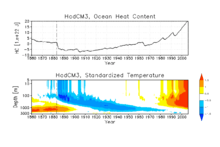Volcanic impacts on the oceans
Explosive volcanic eruptions affect the global climate mainly through injecting sulfur bearing gases into the stratosphere, which oxidize to form sulfate aerosols. Stratospheric sulfur aerosols spread around the globe by the atmospheric circulation, producing surface cooling by scattering solar radiation back to space. This cooling effect on the ocean surface usually lasts for several years as the lifetime of sulfate aerosols is about 2–3 years.[1] However, in the subsurface ocean the cooling signal may persist for a longer time and may have impacts on some decadal variabilities, such as the Atlantic meridional overturning circulation (AMOC).[1][2]
Lowering sea surface temperature
Volcanic aerosols from huge volcanoes (VEI>=5) directly reduce global mean sea surface temperature (SST) by approximately 0.2-0.3 °C,[1][3] milder than global total surface temperature drop, which is ~0.3 to 0.5 °C,[4][5][6] according to both global temperature records and model simulations. It usually takes several years to be back to normal.
Decreasing ocean heat content

The volcanic cooling signals in ocean heat content can persist for much longer time (decadal or mutil-decadal time scale), far beyond the duration of volcanic forcing.[2][7] Several studies have revealed that Krakatau’s effect in the heat content can be as long as one-century.[7][8] Relaxation time of the effects recent volcanoes is generally shorter than those before the 1950s. For example, the recovery time of ocean heat content of Pinatubo, which caused comparable radiative forcing to Krakatau, seems to be much shorter. The reason is that Pinatubo happened under a warm and non-stationary background with increasing greenhouse gas forcing.[7] However, its signal still could penetrate down to ~1000 m deep.[1]
Altering sea level
As the thermal expansion is the key factor to the sea level variability, decreased heat content should result in a reduction in global mean sea level on a decadal time scale.[2] However, Grinsted [2007] argued that a significant sea level rise is the first direct response to the volcanic eruption, and after that sea level becomes to drop. One possible explanation for this phenomenon is the imbalance of ocean mass fluxes. After the volcano eruption, evaporation over ocean becomes lower, because it is largely determined by the ocean skin temperature change. The quick response of evaporation to the surface cooling and the delayed response of river runoff to the associated lower precipitation lead to an increased sea level. About 1~2 years later, river discharge becomes less due to the reduced precipitation and less sea ice melting, which cause sea level to drop.[9]
Enhancing AMOC
Results from a number of modeling studies suggest that the Atlantic meridional overturning circulation (AMOC) is enhanced by the volcano activities.[1][10][11] The deepwater formation at the northern end of the Atlantic Ocean allows SST anomalies to be subducted into the deep ocean efficiently because the rate of overturning is altered by changes in salinity. The decreasing summer-time ice melting and precipitation due to the volcano cooling enhance the salinity near the Greenland Sea, and further reduces static stability, which means more surface water sinks into the deep ocean. The studies of Stenchikov et al. (2009) and Iwi (2012) suggest that both Krakatau and Pinatubo may have strengthened the overturning circulation. And the increase in AMOC seems to be strongest at about one decade after the volcano eruption, with a magnitude of about one sverdrup for Krakatau and Pinatubo.[1][11]
References
- Stenchikov, G., Delworth, T. L., Ramaswamy, V., Stouffer, R. J., Wittenberg, A., & Zeng, F. (2009). Volcanic signals in oceans. Journal of Geophysical Research, 114(D16), 1–13. doi:10.1029/2008JD011673
- Church, J. a, White, N. J., & Arblaster, J. M. (2005). Significant decadal-scale impact of volcanic eruptions on sea level and ocean heat content. Nature, 438(7064), 74–7.doi:10.1038/nature04237
- Angell, J. K. (1988). Impact of E1 Nifio on the Delineation of Tropospheric Cooling Due to Volcanic Eruptions. Journal of Geophysical Research, 93, 3697–3704
- Rampino, M., & Self, S. (1982). Historic Eruptions of Tambora ( 1963 ), Their Stratospheric ( 1815 ), Krakatau ( 1883 ), and Agung Aerosols , and Climatic Impact. Quaternary Research, 18, 127–143.
- Angell, J. K., & Korshover, J. (1985). Surface Temperature Changes Following the Six Major Volcanic Episodes between 1780 and 1980. Journal of Climate and Applied Meteorology, 24, 937–951
- Minnis, P., Harrison, E. F., & Stowe, L. L. (1993). Radiative Climate Forcing by Mount Pinatubo Eruption. Science, 259, 1369–1508.
- Gleckler, P. J., Wigley, T. M. L., Santer, B. D., Gregory, J. M., Achutarao, K., & Taylor, K. E. (2006). Volcanoes and climate: Krakatoa’s signature persists in the ocean. Nature, 439(7077), 675. doi:10.1038/439675a
- Delworth, T. L., Ramaswamy, V., & Stenchikov, G. L. (2005). The impact of aerosols on simulated ocean temperature and heat content in the 20th century. Geophysical Research Letters, 32(24), 2–5. doi:10.1029/2005GL024457
- Grinsted, a, Moore, J. C., & Jevrejeva, S. (2007). Observational evidence for volcanic impact on sea level and the global water cycle. Proceedings of the National Academy of Sciences of the United States of America, 104(50), 19730–4. doi:10.1073/pnas.0705825104
- Jones, G. S., Gregory, J. M., Stott, P. a., Tett, S. F. B., & Thorpe, R. B. (2005). An AOGCM simulation of the climate response to a volcanic super-eruption. Climate Dynamics, 25(7-8), 725–738. doi:10.1007/s00382-005-0066-8
- Iwi, A. M., Hermanson, L., Haines, K., & Sutton, R. T. (2012). Mechanisms Linking Volcanic Aerosols to the Atlantic Meridional Overturning Circulation. Journal of Climate, 25(8), 3039–3051. doi:10.1175/2011JCLI4067.1